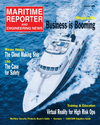
Page 32: of Maritime Reporter Magazine (October 2005)
The Marine Design Annual
Read this page in Pdf, Flash or Html5 edition of October 2005 Maritime Reporter Magazine
Petrobras's first mono-column platform will be installed in the coast of Brazil's Northeastern state of
Sergipe. Hired from Sevan Marine Production ASA, the SSP300 floating unit has the capacity to produce 20,000 barrels of oil per day and to store 300,000 bar- rels. It will start to produce light oil (43º API) in water depths varying from 1,000 to 1,600 m in 2006.
Its double, circular hull unusual geometry is what most interests Petrobras. By the similarity in concept, it will serve to test the recently completed project of a mono-column type platform known as MONOBR. "The MONOBR has design items, such as an external 'beach' and an internal 'moonpool', that reduce the movement caused by the ocean swell," said Isaías
Masetti, the engineer responsible for the MONOBR project.
Although the tests are being carried out in Brazil, the first MONOBR unit most likely will be used abroad. A version, called MONOGoM, has been designed for the
Gulf of Mexico. "We have considered the use of the
MONOBR in the Roncador field in the Campos Basin, and the use of a version for oil storage in the United
States, where Petrobras operates in partnership with another company," said Masetti.
Another project to be launched is the FPSOBR. The basic concept is that future FPSOs will no longer be conversions of existing very large crude carriers (VLCCs). Instead, they will have new hulls specifical- ly designed for oil production needs. "A ship is designed to travel at sea and to work with constant lev- els of load. An FPSO, on the other hand, is constantly loading and offloading oil," said engineer Marcos
Donato Ferreira.
The FPSOBR has many advantages. "Its more square appearance facilitates construction, since its plates do not need to be bent. Also, its dimensions have been designed to allow more appropriate rolling motions than conventional FPSOs: conventional FPSOs roll up to 17 degrees to each side, but FPSOBR rolls only 4 degrees. Theoretically, converting an old tanker is cheaper than building an FPSOBR. But we must take into account the quantity of interventions needed in common ships, due to fatigue of their structure, and the fact that the processing plant equipment has to be heavier and more expensive in a converted tanker to support larger rolling motions. There are also great loads on the risers of an FPSO," Ferreira said. The
FPSOBR will probably be adopted in Phase II of the
Jubarte field, planned for 2010. (Source: Petrobras Magazine) 32 Maritime Reporter & Engineering News
M-2 AIS
Tugs, workboats and fishing vessels can now benefit from the same level of safety navigation.
Like all McMurdo products the
M-2 AIS is designed to perform in the toughest ocean-going conditions.
For information contact: Whiffletree Corporation 156 Whiffletree Lane Marshfield MA 02050 p: 781 837 5892 e: [email protected] w. www.whiffletreecorp.com ? Shipborne Class A AIS ? Clear graphical and text presentation of targets ? Integral 16 channel GPS receiver ? Interfaces to
ECS, ECDIS,
APRA ? Pilot Plug connection ? Flexible installation options ? EASY DECISION
Circle 294 on Reader Service Card
Circle 285 on Reader Service Card ®
PO Box 683 Carnegie, PA 15106 1-800-345-BOLT 412-279-1149 (outside US) FAX 412-279-1185 • www.superbolt.com
For more information, call for a free copy of our catalog,
CD-Rom or video!
Superbolt ® Tensioners are the solution!
BENEFITS: •Only hand tools required •Replaces existing nuts •More clamping force •Greater preload accuracy •No thread galling •Safe to use •Faster than other methods
Superbolt Tensioners eliminate common bolting problems and provide fast, dependable bolting.
BOLTING PROBLEMS?
Ship Rudder
Many other applications!
Marine Design
Two New Brazilian Hull Concepts
First model of the MONOBR, Petrobras's mono-column platform
The FPSOBR, another hull concept created by Petrobras
MR OCTOBER 2005 #4 (25-32).qxd 9/29/2005 8:09 AM Page 32

 31
31

 33
33
